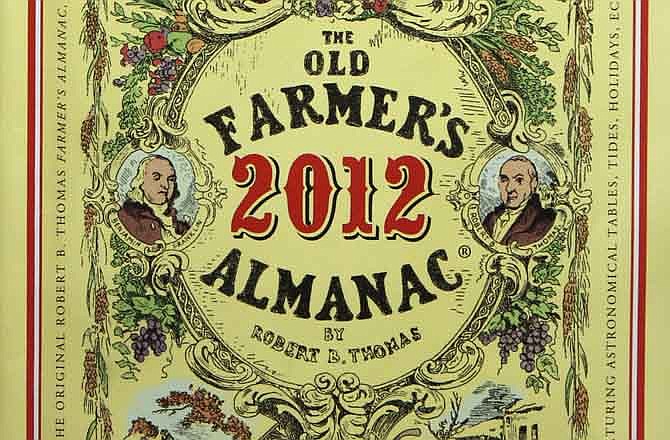DUBLIN, N.H. (AP) - One reader suggests recycling saved greeting cards by adding new messages. Another advises cutting single ripped legs off of two pairs of pantyhose and layering them to create one pair that's good as new.
The tips may sound old-school, but the editor of this year's edition of "The Old Farmer's Almanac" hopes they'll resonate with people looking to save money and pare down their lives in tough economic times.
"We've been real simple before Real Simple was real," Editor Janice Stillman said in Dublin, where the almanac is compiled. The 2012 edition comes out Tuesday.
The 220-year-old book, believed to be the oldest continuously published periodical in North America, has always tried to help readers be resourceful by providing home remedies, weather predictions and even the best days to quit smoking and plant crops based on the moon's position.
"The Old Farmer's Almanac" is 26 years older than its closest competitor, "The Farmers' Almanac," published out of Maine. This year's edition focuses on returning to a simpler lifestyle - cooking at home, growing vegetables indoors and picking up "lost" kitchen arts such as sausage making and pickling. In the words of founder Robert B. Thomas in 1792, the almanac's goal is to be "useful, with a pleasant degree of humor."
The "2012 at a glance" section predicts the growing popularity of simple entertainment such as Sunday dinners and parlor games, along with sharing or renting furniture, clothing and cars. It says people also are feeling a sense of nostalgia and collecting fancy hats, silver tea services and typewriters.
Submissions came pouring in for this year's essay contest, for which readers were asked to write about their best original money-saving habits.
"This was on people's minds," Stillman said.
First place went to Elizabeth Gortemoller, 82, of Elkhorn, Wis., who had the idea of reusing greeting cards her family had saved because they were meaningful.
"All we had to do was add a new date and message - and reading the old messages was a joyful trip down memory lane," wrote Gortemoller, whose mother used to scold her children for paying too much for cards.
The recycling idea was also a way to help her mother, who had Alzheimer's disease.
"I would put the group in front of her, like for my birthday, and I'd say "Ma, pick out a card for me,"' she said. "She would go through them and choose one," writing a new message to her daughter.
Gortemoller, a retired schoolteacher who grew up reading the almanac, she said looks forward to the variety of articles. This year's edition includes tips on getting rid of unpleasant odors and a survivalist quiz to celebrate the 100th anniversary of the Girl Scouts. There's also a collection of macaroni and cheese recipes "outside the box;" a brief history of spit through the ages; and a list of the best insults of all time.
Third-place winner Regi Johnson's money-saving tip was in response to an office policy that didn't allow women to show bare legs when wearing a dress. She often found that she never had a good pair of panty hose because they always had runs or holes. But she had several pairs that had one good leg, and since she always bought the same brand and color, she cut the bad leg off each pair and slipped on both of the good pairs.
"The bonus was extra control," said Johnson, 52, an insurance agent in Manhattan, Mont.
In addition to all the advice there are, of course, the weather predictions, which the almanac says were 90.6 percent accurate for last winter. They're based on a secret formula Thomas designed using solar cycles, climatology and meteorology.
Jud Hale, longtime editor in chief, said there's something comforting to people who see the familiar yellow cover, unchanged since the 1850s. People tell him their grandmothers swore by it or hung it up on a hook in their homes; the publication has long had a hole punched in the upper left corner to hang in outhouses or family rooms.
"That kind of reaction is universal," Hale said. "And when we get the weather wrong, they forgive us. When we get it right, we get tons of congratulations!"
According to the almanac, this year's weather highlights for November to March are:
- Temperatures will be below normal, on average, in most of New England, the Mid-Atlantic, South Florida, the Upper Midwest, the Desert Southwest and the Pacific Southwest. Temperatures will be above normal elsewhere.
- Precipitation will be above normal in the eastern Ohio Valley and in the northern portions of the Upper Midwest, Pacific Northwest, and Pacific Southwest and below normal elsewhere.
- Snowfall will be above normal in most locations from New England south to Georgia and west across the northern tier of states to the Cascades of Washington and Oregon. It will be below normal in most other areas that usually see snow.
---
Online:

